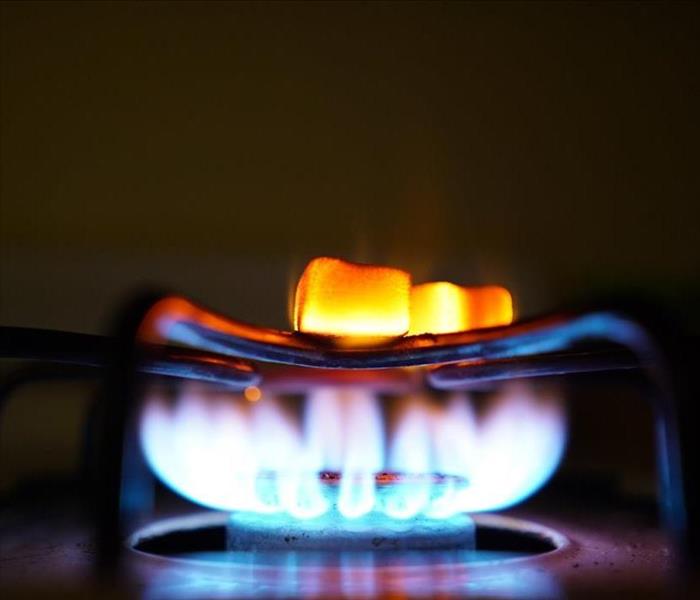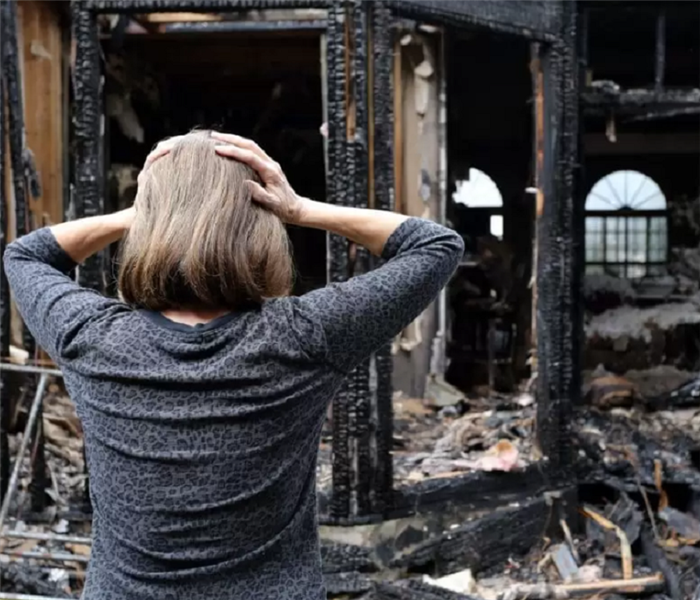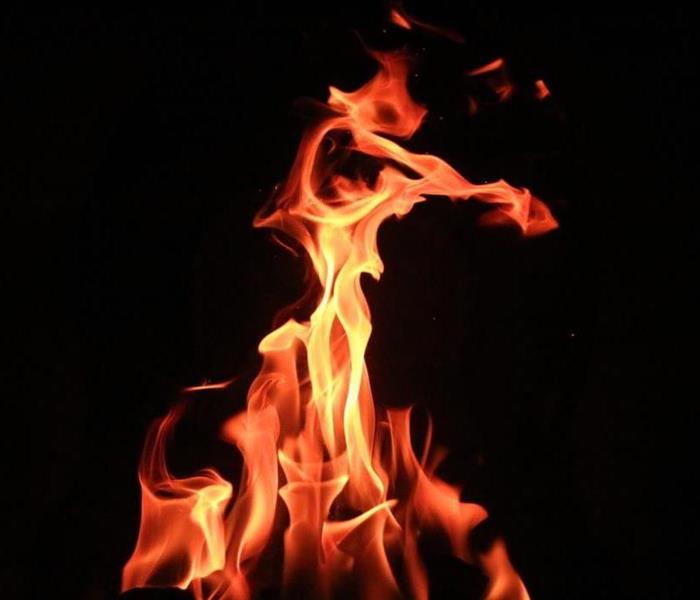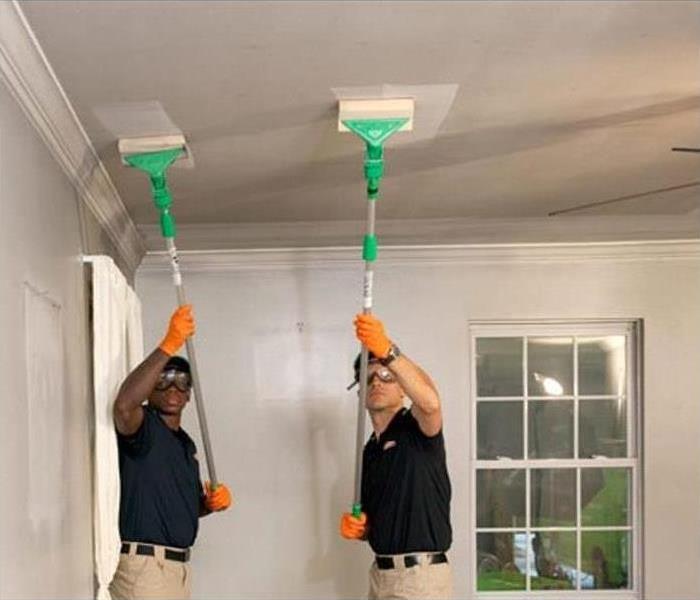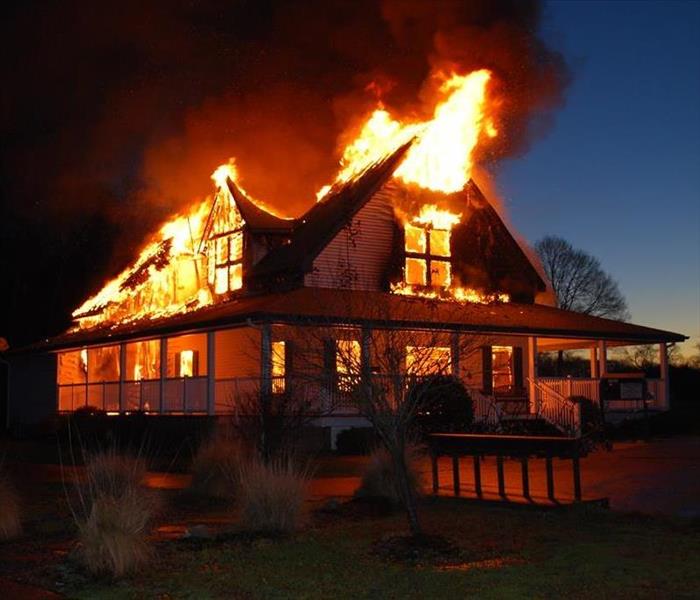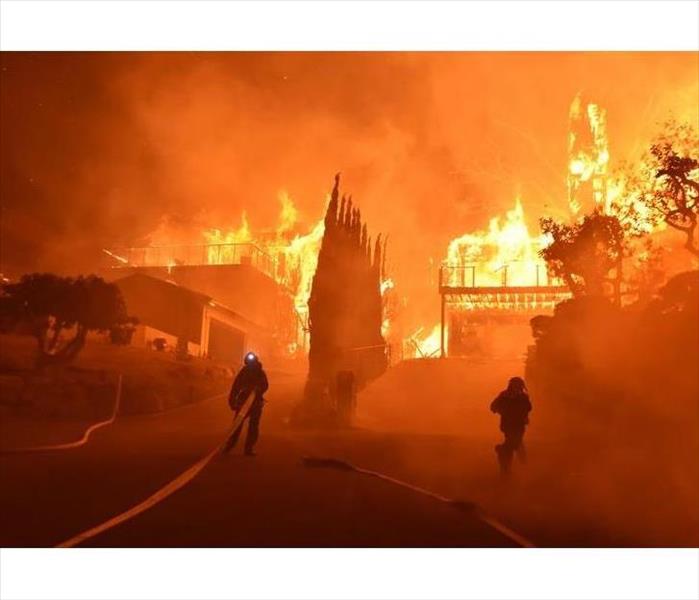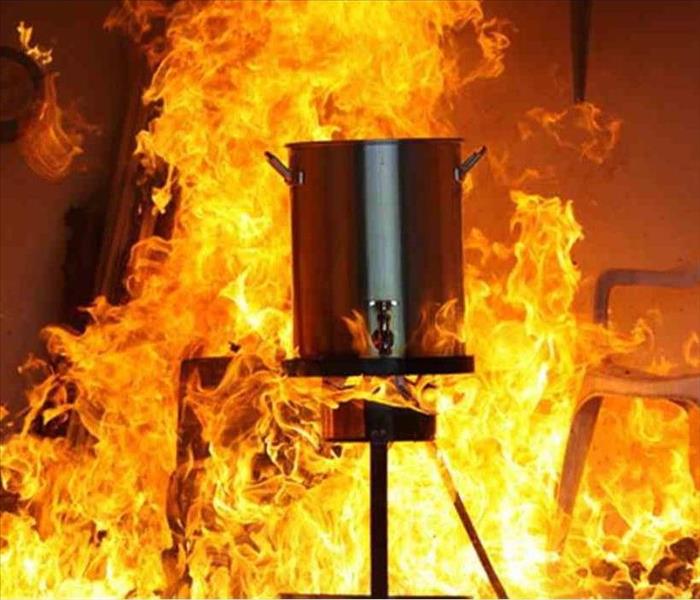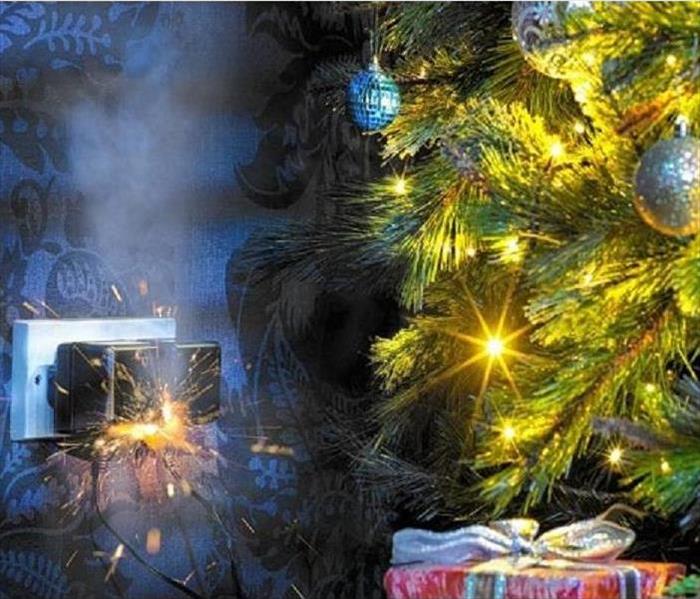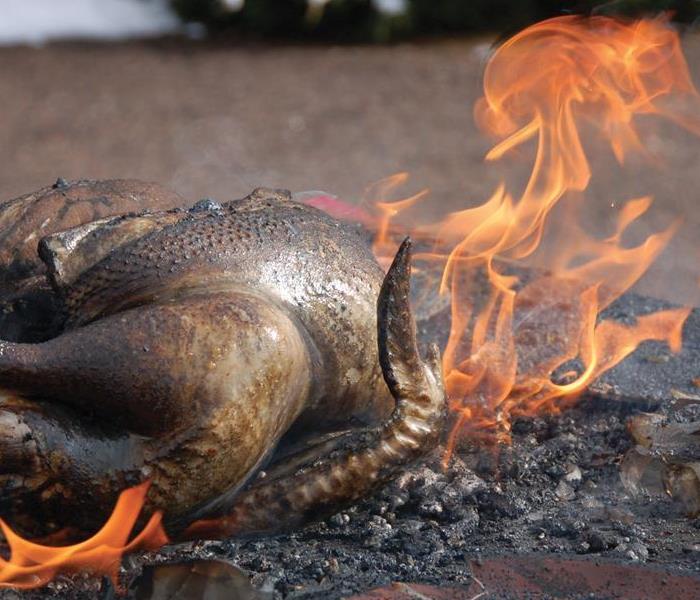Recent Fire Damage Posts
Steps to Take During a Brush Fire: Ensuring Safety and Preparedness
11/6/2024 (Permalink)
Brush fires, also known as wildfires, can spread rapidly, fueled by dry conditions, high winds, and an abundance of flammable vegetation. In California, where brush fires are a seasonal threat, understanding what to do during a fire can make a huge difference in your safety and the protection of your property. While preparation is key, it’s just as important to know the steps to take when a brush fire is actively threatening your area.
Here are some essential steps to take during a brush fire to protect yourself, your loved ones, and your home.
1. Stay Informed
The first step in handling a brush fire is to stay informed about the fire’s location, movement, and any evacuation orders. Use the following resources to get accurate and timely updates:
- Emergency Alerts: Sign up for local emergency alerts via text or app notifications to receive real-time information about fire warnings and evacuations.
- News Stations: Keep an eye on local TV stations or radio channels that provide continuous coverage of the situation.
- Social Media: Follow your local fire department, law enforcement, and emergency management agencies on social media for real-time updates.
It’s crucial to have multiple sources of information, as conditions can change rapidly during a brush fire.
2. Evacuate When Ordered
If an evacuation order is issued, leave the area immediately. Your safety is the number one priority. Here are some tips to make your evacuation as smooth as possible:
- Have an Emergency Kit Ready: Keep a kit with essential items (medications, important documents, flashlight, water, snacks, and a change of clothes) in an easily accessible place.
- Follow Evacuation Routes: Do not take shortcuts or use unfamiliar roads. Follow the designated evacuation routes provided by local authorities to avoid roadblocks or unsafe conditions.
- Leave Early: Don’t wait until the last minute to evacuate. Fires can move quickly, and waiting could put you at greater risk. Evacuating early helps you avoid getting caught in traffic or the flames.
If you have pets, make sure they’re safely evacuated as well. Prepare carriers and have their food, medications, and identification with you.
3. Protect Your Home and Property (If Time Allows)
If there’s still time before an evacuation order or the fire reaches your area, take steps to protect your home. Even though your personal safety should always come first, these actions can help minimize the damage to your property:
- Close All Windows and Doors: Close all windows, doors, and vents to prevent embers from entering your home and starting fires inside. If possible, cover windows with fire-resistant materials.
- Move Flammable Items: Move anything flammable (such as firewood, lawn furniture, or propane tanks) away from your home and into an area that is clear of vegetation or away from structures.
- Turn Off Gas Lines and Electricity: If there’s time, turn off the gas supply to your home and shut down any non-essential electrical equipment to prevent fires from igniting due to sparks or gas leaks.
- Create Defensible Space: Clear leaves, branches, and other combustible debris from around your property, particularly near windows, doors, and rooftops. Raking up dry vegetation and trimming trees can make it harder for the fire to spread to your home.
4. Keep a Clear and Safe Escape Route
Make sure your escape route is clear of obstructions. If you're leaving by car, ensure your vehicle is fueled and ready to go. Avoid parking on dry vegetation or grass, as this could ignite during the fire. If you must leave on foot, have a clear path that avoids any flames, smoke, or falling debris.
When driving, keep the windows up, and turn on the air conditioning to keep smoke out. Avoid using the car's air circulation, as it can draw in more smoke from outside.
5. Don’t Re-enter the Area Too Soon
Once you’ve evacuated, do not return to your home until local authorities give the all-clear. Fires can reignite unexpectedly, and even if the fire appears to be under control, there may still be dangers such as embers or unstable structures. Your safety is most important, so wait for official word that it's safe to return.
6. Follow Safety Procedures in Smoke-Impacted Areas
If you’re in an area affected by smoke but not immediately at risk of the fire, take steps to protect your health:
- Limit Exposure: Stay indoors as much as possible. If you must go outside, wear a mask (N95 or similar) to reduce inhalation of smoke and ash particles.
- Seal Off Doors and Windows: Close doors and windows to keep smoke from entering your home. Use air purifiers if available.
- Monitor Air Quality: Keep an eye on air quality reports and follow guidance from health officials to avoid unnecessary exposure to harmful smoke.
7. Check on Neighbors and Vulnerable Individuals
If it's safe to do so, check on elderly neighbors, children, and those with mobility issues to ensure they are prepared or have evacuated. Many people may not have the resources or ability to leave on their own, so offering assistance could save lives.
Brush fires are unpredictable and often life-threatening, but with proper planning and swift action, you can help ensure your safety and minimize the damage to your property. Stay informed, follow evacuation orders, and take steps to protect your home when possible. Most importantly, always prioritize your safety and the safety of others, especially when time is of the essence.
Remember, fires can change direction rapidly, so it’s crucial to stay updated on local conditions and follow the guidance of emergency professionals. By remaining vigilant and prepared, you can greatly increase your chances of making it through a brush fire safely.
What to Know About Gas Leaks
12/13/2022 (Permalink)
It is everyone’s worst nightmare to have a fire ignite in their home. But with all of the technology stored and used in our homes, the event has a notable chance of occurring. One cause of fire that many people often do not notice are gas leaks. Gas cannot be seen and sometimes the leak cannot be heard. Here are some signs of a gas leak to help you identify if you are faced with the problem or not:
Smell
If the aroma in your home has changed to a gas-like smell or sulfur egg-like smell, that is one big sign something is up with your gas line.
Dead Plants
If your gas line is leaking, the content of it in the air will wither and kill your plants. Keep note of how your plants are doing!
Hiked Gas Bill
The excessive leaking of gas will cause your bill to rise, so if the price is out of the norm check the line.
Dust Cloud Around Gas Line
The leaking of gas will cause dust and dirt to possibly be thrown in the air around the affected area.
Hissing Sound
If the gas is leaking from a small hole in the line, it will make a hissing sound as it escapes the small area.
After noting all of these signs and you come to the decision you have a gas leak, evacuate your home and call 911 or SoCal Gas at 1-800-427-2200. Do not light any matches or flip any switches, as this will spark a fire. If you have any more questions, don’t hesitate to call us at our 24 hour service line. SERVPRO is here to help!
Read This to Familiarize Yourself With The Classes of Fire Damage
8/31/2022 (Permalink)
To restoration companies, fire damage refers to the physical damage to structures or property as a result of burning. Most often than not, the damage is caused by corrosive substances, flames, and smoke. At SERVPRO, we are glad to inform you of 6 types of fire damage:
Class A- a fire that entails liquids or solids that can change into liquids.
Class B- a fire that entails flammable solids such as plastics, woods, or cloth.
Class C-fire is caused by combustible metals such as potassium or magnesium
Class D- relatively hotter and more debilitating including fats and cooking oils.
Class E: fire that involves gasses such as butane, propane, and hydrogen including natural gas.
Class F: fire that involves conditions in class A and B and electrical components.
Moreover, multiple insurance companies dissect fire damage into primary and secondary. The primary is concerned with fire damage caused by flames while a secondary entails damage caused by smoke and other substances. There is also spontaneous combustion which occurs when an organic matter is set on fire due to an internal source, when it trickles down to insurance, it is a unique clause in property and fire policies that entitles the policyholder to compensation for the fire damage. It is peculiar because it is not often included in common fire and common property policies. A property situated in a location where earthquakes frequently happen is insured with legislation that covers damage brought by an earthquake. The same applies to commercial buildings with hazardous components such as flammable oils and liquids.
At SERVPRO, we will manage all your frustrations with our trained experts ready to help at any time. Reach out to us, we will be more than glad to help!
The Steps to a Speedy Fire/Smoke Damage Restoration Process
8/3/2022 (Permalink)
According to the National Fire Protection Association (NFPA), there is a fire department situated somewhere in the United States that responds to a fire every 24 seconds. A fire can be a frustrating experience, and the thought of restoring fire-damaged property can be overwhelming. It is restoration experts who are largely tasked with returning structures to their original state. Fire restoration entails cleaning up and the process can take weeks or months, considering the destructive nature of the disaster.
The process may also involve demolition, property board, and reconstruction on top of projects such as soot removal, removing disturbing hazards, and debris mitigation. Notably, fire and water damage often occur concurrently. This is because the structure is doused with water while the fire department strives to extinguish the inferno. Sometimes pipes burst during the fire which leaks water into the property. The following are steps of how the fire damage restoration process is performed:
Damage Assessment
Involves a contractor evaluating the damage sustained in the fire and how smoke and flames penetrated the structure. Security of Property and Removing Debris
The next step includes installing fencing around the structure and boarding up openings in the property. Water mitigation and dry-out
The objective is to circumvent further damage caused by corrosion or mold by removing water. Personal property will be removed from the interior of the structure and roof tarps maintained during this phase of restoration. Smoke removal and Clean Up
This is the most intensive part of a fire damage restoration task. There is a lot of manual labor to clean soot and smoke from interior and exterior surfaces. Construction and Restoration
This is the final step in returning the structure to its original condition. Some parts of the structure may be totally unsalvageable during the initial evaluation, and therefore have to be removed and replaced.At SERVPRO, we care about you and are always ready to dispatch our team of experts to help with all your restoration needs. Feel free to reach out!
Additional Information About Home Fire Damage
7/13/2022 (Permalink)
Imagine the most valuable belongings in your home right now. It could be an item from your childhood, or something impossible to replace because of its uniqueness. Would you be able to save this item from a fire in your home? The following are tips to protect your homes from fire damage, courtesy of SERVPRO:
? Always remember to blow out candles before leaving any room. While it may look fancy to electricity by having burning candles all around your home, they can result in a disaster if left near something flammable.? Learn how to put out a small pan fire. Also, know how to eliminate a grease fire and use the back burners with the panhandles.? Do not install smoke alarms near ducts, doors, and windows as they can fail to work properly. Ceiling-mounted alarms should be installed at least 4-inches away from the nearest wall? Keep plenty of space around your space heater and ensure it is tested for safety.In an intricate fire, especially where plastics are burned, the acid gasses amalgamate with water vapor and heat and then penetrate crevices. Also, when surfaces cool, the gasses form highly corrosive solutions. These solutions can permanently stain or etch multiple sensitive surfaces including household appliances, precision instruments, and tools. While the chemistry of fires may vary, the most important thing is to dry out the area promptly. At SERVPRO, we recommend that you carefully consider the surfaces and materials affected. This will provide an understanding of the fire’s chemistry and enable a targeted ad informed restoration effort. Feel free to call us in case you need our exceptional services from trained experts.
Happy Summer! Here's How to Prevent and Prepare for Fires
6/15/2022 (Permalink)
A house fire is one of the most frustrating types of structural damage. Although it is fortunately not a common phenomenon, there are around 100,00 fire-related incidents in the U.S every year. If you have been in the catastrophic situation of suffering a house fire, it is always advisable to assess how much your damage or business has suffered, and all the valuables lost in the fire. At SERVPRO, it is our mandate to ensure that you are well-informed about the dynamics surrounding fire damage. The following are the three types of fire;
Flame Damage
There are several types of flame damage depending on the source of the fire. For instance, an electrical fire may have a different impact on your home or business compared to those caused by a naked flame like a match. It is pivotal to choose a restoration company that is a professional in this area and totally discerns the distinct types of fire damage. This is primarily because a poor rebuild often results in problems appearing in the future, and can make your home unsafe.
3rd Party Damage
Fire damage is not just limited to the damage caused by smoke and flames. A house fire opens the possibilities for other vulnerabilities and problems. For instance, the water used by firemen to assist eradicate the flames can be absorbed into your floorboards and walls- making them warp, leading to plaster falling off. Chemicals that were present in the fire will need to be cleaned by an expert to circumvent any future damage. Further, the heat from a building fire can cause damage to your walls, leaving holes and cracks. These holes serve as an easy access point for rain and other weather issues. Filling the cracks and holes is not enough as they could be masking more grave problems. Ensure that your premise is inspected by a structural engineer.
Smoke Damage
This sort of damage is a long-lasting impact of fire damage and can persist for weeks or months after the fire is extinguished. To illustrate an idea of how smoke damage works, you can smell smoke on a person that is just from a cigarette break, because smoke sticks to objects. In the same manner, it will stick to walls, furniture, ceilings, and flooring. Smoke will discolor surfaces in your house, making them difficult to clean. A certified restoration professional will know exactly how to clean all your items and remove smoke damage completely.
If you have encountered fire damage and need advice on dealing with your insurance company, feel free to reach out to SERVPRO of Lake Forest South & Laguna Woods. We are a fire damage restoration professional and will work with you to ensure your home or business gets back to normal as soon as possible.
Stay safe!
Smoke and Fire Damage Tips for Southern California's Summer
6/13/2022 (Permalink)
The periods after a fire can cause frustration. SERVPRO recommends the following tips to fire damage restoration to help you prevent damage to your home or business.
Smoke and fire damage tips:
?Do not try to clean upholstered furniture or carpets. The wrong procedures could intensify the damage.?Do not try to wash flat painted walls devoid of consulting your professional cleaner.?Avoid using electrical appliances that have been exposed to water or fire. They could malfunction if unchecked.?Avoid consuming food exposed to fire or smoke?Do not touch anything because soot on your hands can permeate woodwork, and walls causing further damage.If you have suffered loss caused by fire or smoke; the following are various ways you can handle the damage before a restoration company visits to assess the damage.
?Cover carpeted traffic areas with old linens or towels to avoid annexed soiling.?Brush-vacuum any loose soot particles from carpets, drapes, and upholstery.?To prevent porcelain bath fixtures, wipe residue to avoid etching?Send clothing with heavy smoke damage to an expert who can dry clean them?Air out the house to eradicate smoke odor, if the room is above 60 degreesRegardless, we advise that you get in touch with your insurance agent promptly. One the initial phone calls, you need to contact your insurance provider. Prior to engaging with plans to restore your premise, inform your agent concerning the damage so that details of the policies can cater to any overlooked or missed aid. For instance, a fire report entails the pivotal details surrounding and contributing to the fire damage. It also involves mundane information like the date and time, location, and source of the fire. All this data is vital to your insurance claim. Feel free to reach out to SERVPRO, we will take care of everything!
Prepare an Emergency Bag to Stay One Step Ahead of Natural Disasters
8/18/2021 (Permalink)
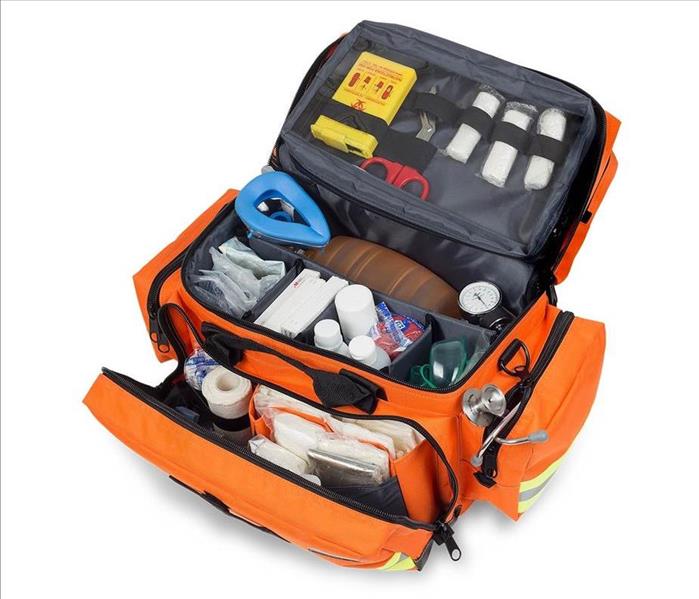 Here is an example of an emergency pack to keep in your residential or commercial property. Stay prepared and safe!
Here is an example of an emergency pack to keep in your residential or commercial property. Stay prepared and safe!
In the face of natural disasters, all we can do is stay safe by being prepared. It’s hard to predict when or how a natural disaster will occur, or if it even will. But, it will confront you at the most unexpected of times, which is why it’s good practice to have an emergency bag in an easily accessible place for a time you may need it to save your life!
So, what items should you have in your emergency pack? Here are some key things to invest in for your emergency bag:
- Water
- Nonperishable food
- Batteries
- First-aid kit
- Matches
- Toiletries
- Wet wipes, toothbrushes/paste, travel size soap, a roll of toilet paper, garbage bags
- Whistle
- Local maps
- Phone charger/Portable Battery
- Dust masks
- Flashlight
- Small foldable emergency blanket
- Necessary medicines and prescriptions
- Spare keys for your home and car
- Copy of identification cards
- ID, driver’s license, passport, SSN, insurance cards
- Emergency contact list
- Change of clothes
- Shoes
Now, what should hold all of these emergency items? Well, the items can be placed in a bucket, plastic bag, backpack, or any other method of carrying things easily. Some emergency packs even have special bags that can fold out into an emergency blanket. Specialized ones like these can be bought at your local superstore or online. Stay prepared for disasters, and if one happens to you, we are here to mitigate the damage.
Preparation for Southern California's Scorching Summers
8/2/2021 (Permalink)
Here in Southern California, our summers can get hot. With temperatures reaching over 100 degrees, this is the catalyst for many brush fires that sweep the state every summer. These fires have the unfortunate potential of reaching residential areas, which is why being prepared for a fire should be in the mind of one who lives in high risk areas.
To prepare for these situations, consider making an emergency home kit. Our blogs go into detail about the types of materials you want to add to the kit to ensure you’re as prepared as possible if that tumultuous time ever arrives. Even if you are not in a high risk area, it is still wise to equip your home with an emergency kit because the events of the future can never be predicted.
In addition to brush fires, the appliances in your home could be a potential catalyst of fire. Since temperatures are higher than usual, these appliances have a greater risk of overheating, potentially causing a fire. To prevent this, read our blogs on annual home inspections. This will give you information on how to inspect different appliances and tools in your home to make sure they are functioning properly, minimizing any potential for dangerous malfunction.
Take this as a reminder to note the change of seasons and how it could affect your home or surroundings. Here at SERVPRO we are dedicated to providing you with not only the best restoration services but with great information to prevent us from having to make it “Like it never even happened,” in the first place. For any questions, or to schedule an inspection, call our 24-hour service line at (949) 429-3188.
What Our Technicians Look For When Inspecting Fire Damage
6/30/2021 (Permalink)
At SERVPRO, fire and water damage remediation is our specialty. So let’s talk about fire! Accidents happen and when they do we are here to clean it up. With over 50 years of experience in the disaster recovery business, we know how to make your property “Like it never even happened.” When confronting fire damage, there are a wide range on things to take account for in the inspection process. Here are some of the things we look for:
Soot and Ash
A fire produces heavy amounts of smoke from the burning of different materials that your home is made up of. The remnants of the smoke are soot and ash that can be left on the walls, ceiling, furniture, and floors. It visibly stains the areas, making your property look dirtied with fire damage! But, no need to worry, this can be fixed. Here at SERVPRO, we use special vacuums to suck up the ash and soot, but sometimes even after cleaning the smell remains. In these cases, the affected areas must be replaced to eliminate the odor in your property.
Burnt Areas
These are the most obvious places that need to be replaced. Once the supporting beams, walls, and ceiling of your house is touched by fire, the structural integrity of it is greatly compromised. You can see which areas of your house are affected because everything is burned visibly black. These areas are removed and reconstructed to keep your property safe and looking “Like it never even happened.” At SERVPRO, we have the certifications to remediate your damaged home AND reconstruct it. You can choose us or a separate construction company to proceed with the final rebuild of your property. Check out some of our construction before and after photos here.
Electrical Problems
A fire can directly damage the electrical outlets and wiring by melting and burning them, or indirectly through heat and smoke. They can also be damaged by water from firefighting efforts. We check for all of these things when inspecting your property after fire damage. It is usually light fixtures, outlets, and exposed electronics that must be completely replaced following a fire. But, we have seen cases where a property’s internal wiring is damaged and must be completely repaired. Our highly trained technicians have the certifications and experience to restore every range of damage that a fire has done to your property.
These are some of the key things we look for after fire damage, and we share so you know if your home is in need of damage restoration. If you are not sure, call our 24 hour emergency line to schedule an inspection, or even for any questions you may have about our services.
The True Costs of Fire Damage
6/23/2021 (Permalink)
According to the National Fire Protection Association (NFPA), home fires play a major role in property damage, injuries, and loss of life in the U.S. According to their 2017 statistics, 72% of all resident fatalities were caused by home fires.
Other than cooking appliances, home fires are caused by many things such as faulty heating equipment, defective electrical equipment, burning candles, and irresponsible smoking inside the house. Fire alarms and smoke detectors can help in detecting when the fire starts, and it can reduce the amount of damage caused by fire by helping you call the fire brigade on time.
Home fires should not be taken lightly because they result in loss of property as well as precious human lives. Fire damage results in high restoration costs that homeowners find difficult to cope up with. Taking preventative measures to prevent fires is a good idea, but they don’t always work. Here are the major damages that homeowners have to bear when fire engulfs their precious belongings.
Damaged Furniture, Carpets, and Rugs
Fire can eat up your wooden furniture and destroy your expensive rugs and carpets. Dealing with these damages is not an easy task. In case of such a situation, you must call a professional fire damage restoration company to restore your expensive furnishings. The trained professionals will visit your house and inspect all of your furniture to see what can be restored and what needs to be replaced. If your furnishings have not been completely engulfed by the fire, the professionals will restore them back to their original condition. Otherwise, you will have to spend a lot of money on replacing those items with new ones.
Electrical Equipment
Electrical devices have made our lives easy and that’s why our homes are full of them. Home fires damage these expensive electrical devices and homeowners have to pay a huge price for it. If the damage is not severe, these devices can be fixed by an electrician. Otherwise, the only option left is to replace them with new devices and equipment.
Soot Deposits on Walls
Soot deposits are part of the damage caused by fire. It is a black powdery substance that is produced as a result of partial combustion of organic substances. It gets deposited on walls, windows, doors, roof, and furniture – basically everything. A professional fire restoration company can help you get rid of the sticky black soot. The trained professionals will inspect your house and decide which method of cleaning is suitable for soot removal. Through their expertise, they will restore everything in your house to their original condition.
Loss of Important Documents
One of the major fire damages is the loss of important documents. If your documents such as passports and social security cards get completely burned during a fire, they cannot be restored. All you can do is contact the respective authorities and discuss your situation with them. They will help you find a solution.
Fire damages are a menace for homeowners because they have to deal with the hectic process of restoration. Calling a professional company like SERVPRO to help you out is the best option. You can count on the professionals to assist you in aptly restoring fire damages.
Do Not “DIY” Damage Restoration! And Here’s Why...
6/16/2021 (Permalink)
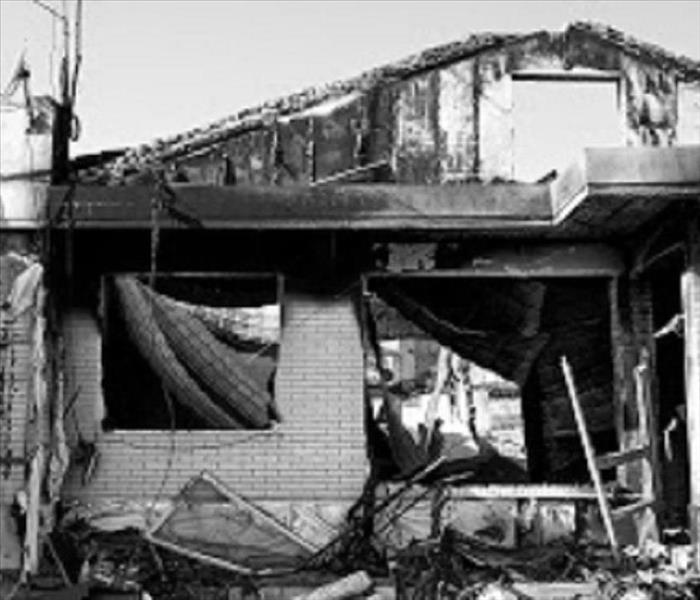 Fire can be a formidable feat of nature, but SERVPRO is here to cleanup the mess and mitigate the aftermath.
Fire can be a formidable feat of nature, but SERVPRO is here to cleanup the mess and mitigate the aftermath.
Restoring your house after it catches fire is one of the dreadful things in life. Read on to know why you should always hire a professional for fire damage restoration instead of fixing the damage yourself.
What’s worse than thinking about catching a fire in your house? It puts you, your family, your pets, and all of your precious belongings in danger.
Your house can catch fire because of numerous reasons such as cooking disasters, electrical wiring faults, malfunctioning heating equipment and burning candles. The damage caused by fire depend on its intensity. A huge fire can eat up the whole family while a small one might only leave black burn marks on a wall.
It’s best to call a professional company for fire damage restoration. They will help you get rid of burn marks, soot deposits and burning odor inside your house. Moreover, you would be in a state of shock after your house catches fire. It’s better to call a fire restoration company and allow them to handle the mess.
Here are the reasons why calling a professional fire damage restoration company is better than DIY.
- They Offer Emergency Services
Fire damage restoration services offer 24/7 emergency services. You can call them whenever there is a fire emergency and they’ll come in no time. Without a professional, you won’t be able to handle the aftermath of your house catching a fire. For instance, if your electric kettle catches a fire, you wouldn’t know how to deal with it because after the fire is put out now your looking at water damage to your home as well. Talk about a state of total shock and panic. All you can do at that time is call a professional fire damage restoration company to help you out.
- They Will Properly Inspect Your House
A professional fire restoration company will thoroughly inspect your house for fire damages. Along with the black burn spots and soot deposits, they will check if the fire has damaged any of your water pipes or drainage lines. If yes, then they will call the water restoration company to fix the problem. The water restoration company will clean the water, they will call a plumber out to fix pipes and dry your house to prevent mold damage. This wouldn’t happen if you tried handling the fire damage yourself.
- They Will Fix All The Damages
The fire damage restoration professionals will use special chemicals and equipment to remove soot deposits as well as clean the black burn spots on your walls and ceiling. They will use special deodorizers to make sure that your house gets rid of the pungent burning smell. Moreover, they will use special ventilators and pumps to get rid of all the harmful smoke present inside your house.
You can hurt yourself if you don’t call a fire damage restoration company. If fire smoke enters your respiratory system, it can cause breathing problems and also lead to a cardiac arrest. So, it’s your best interest to call a fire damage restoration service.
Damage caused by fire should not be taken lightly. Always call a professional fire damage restoration company if your house catches a fire. There is more to cleaning up after a fire than you think.
CALL SERVPRO of Lake Forest/Laguna Woods for your Fire and Water Damage needs at (949) 429-3188
How to Classify the Different Types of Fire
6/9/2021 (Permalink)
Fire can occur anywhere and at any time due to minor negligence. It can break out in your house due to misuse of electrical appliances or by smoking near combustible equipment. Similarly, the carelessness of managers and employees can cause fires in industrial and manufacturing units. If you want to save your home or office from such an incident, then you need to understand the different classes of fires.
Classes of Fire
There are five classes of fire based on their source of ignition.
Class A: Ordinary Combustibles
Class A fires are caused by the materials that reach their ignition temperature due to reasons such as a discarded lit cigarette. They keep burning as long as there is a supply of heat, fuel and oxygen. The items that produce these types of fires include textiles, paper, woods, some specific plastics, rubber and other
organic carbon-containing compounds. You can install foam fire or water-based extinguishers to counter this type of fire.
Class B: Flammable Liquids
These fires are caused by liquids such as alcohol, petrol, kerosene, paints and solvents that burn easily at temperatures below 100° C. They ignite immediately if a flame is brought in their close vicinity. Class B fires produce thick black fumes and spread quickly, which makes it difficult to put them out. You can use a foam fire extinguisher to extinguish them.
Class C: Flammable Gases
Flammable gases such as petroleum gases and butane can explode and cause fires by a single spark. According to the lower explosive limit (LEL), a concentration of just 5% of these gases in the air can cause an explosion. Dry power extinguishers are the only ones that can counter them.
Class D: Combustible Metals
Ignition of metal shavings and powdered metals causes these fires. They usually take place in industrial and manufacturing units when alkali metals such as magnesium, potassium, sodium and aluminum come in contact with water and air. You can put out these fires in early stages by special class D extinguishers. Once they have spread out, they are usually left alone because they produce a lot of ash, which cuts off the fire’s oxygen supply.
Class K: Cooking Oils
These fires are caused by cooking oils and usually break out in homes, restaurants and professional kitchens. These fires are quite a challenge to extinguish; therefore, only special extinguishers can put them out.
Safety tips on smoke alarms
2/28/2020 (Permalink)
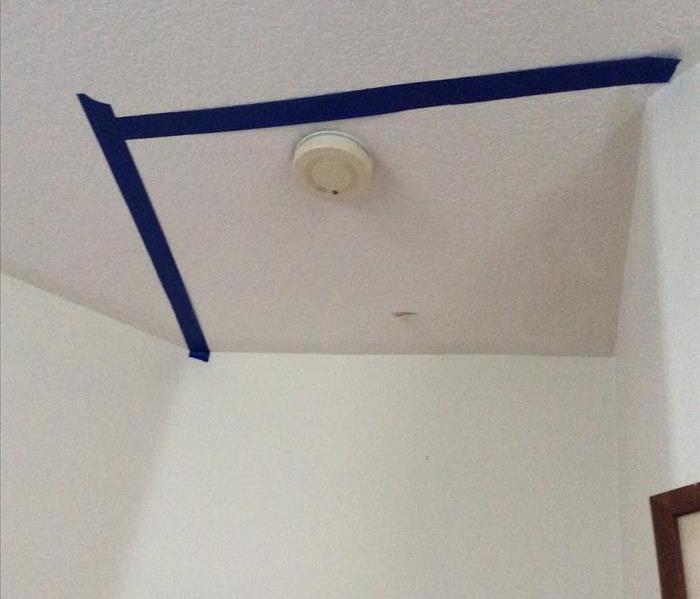 Smoke alarm already set up.
Smoke alarm already set up.
Properly Maintain Smoke Alarms
- Test units monthly.
- Install new batteries immediately when the low-battery warning alarm sounds or at least once a year.
- Clean smoke alarms regularly by vacuuming them with a brush attachment.
- Replace smoke alarms every 10 years to achieve optimum performance.
Where should you not put smoke detectors?
Don't install the detector
- On windows or sliding doors as the winds and air may not pick up the heat of smoke or fire.
- In humid or moist areas including the bathroom.
- In areas that easily collect dust and dirt including unfinished attics.
- In cooler rooms such as sunrooms or porches.
- Near ceiling fans or air vents.
How does a smoke alarm increase fire safety?
A smoke alarm is a device that combines smoke detection and a loud alarm together in one unit. The alarm sounds if it detects smoke in large amounts, like in a fire. A smoke alarm, when properly installed, tested, and maintained gives you an early warning of a fire, which increases your chances of getting out.
For any questions don’t hesitate on calling us SERVPRO of Lake Forest/Laguna Woods it’s here 24 hours at day to serve you at any time. Call us at (949) 429-3188 here to help.
Tips to prevent fires
2/28/2020 (Permalink)
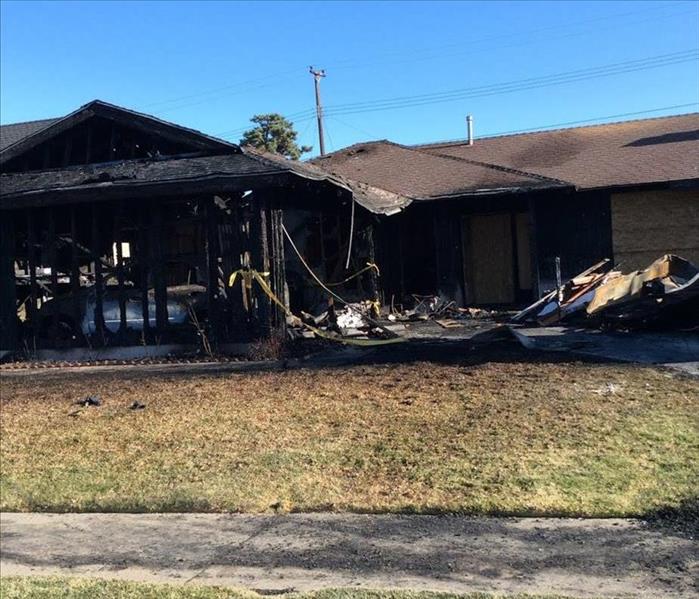 This is a photo of a house that got on fire.
This is a photo of a house that got on fire.
Top 10 Tips to Prevent House Fires
- Test Your Smoke Alarms Regularly. The easiest way to avoid a house fire is by checking your smoke alarms regularly.
- Inspect All Your Heating Sources.
- Keep Your Stove and Oven Clean.
- Don't Leave Your Kitchen.
- Always Check Your Dryer.
- Maintain All Cords.
- Properly Store Flammable Products.
- Practice Caution with Candles.
How can we protect fire?
How To Prevent A Fire
- Install fire alarms and smoke detectors.
- Teach children the basics of fire safety and how to prevent, prepare for, and deal with a fire.
- Always keep matches and lighters out of the reach of children.
- Keep flammable items at least three feet away from anything hot.
We also recommend you talk with all family members about a fire escape plan and practice the plan twice a year.
Precautions when cooking with gas
2/7/2020 (Permalink)
 Keep stove clean and clear for safety.
Keep stove clean and clear for safety.
Tips on cooking (with Gas) safely:
- Never leave cooking unattended.
- Never get distracted.
- Never allow a child to cook without adult supervision.
- Keep the flame from extending past the pot sides.
- Turn pot handles away from the stove edge.
- Keep stoves and cook tops free of grease and fat build-up.
Gas Stove Safety Tips
- Check the pilot light. Some older gas stoves are equipped with pilot lights which stay lit when the stove is not on.
- Clean the burners regularly.
- Keep handles to the side.
- Inspect your smoke alarm.
- Install a carbon monoxide detector.
- Keep a fire extinguisher close.
Basic Rules of Kitchen Safety
- Store knives in a wooden block or in a drawer.
- Never cook in loose clothes and keep long hair tied back.
- Never cook while wearing dangling jewelry.
- Keep potholders nearby and use them.
- Turn pot handles away from the front of the stove.
- Don't let temperature-sensitive foods sit out in the kitchen.
Signs of a Gas Leak
2/7/2020 (Permalink)
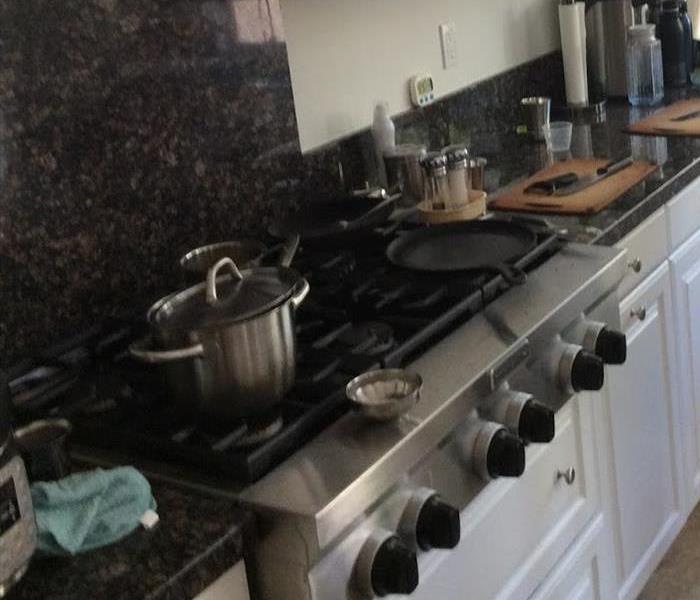 Let's take precautions to prevent a gas leak.
Let's take precautions to prevent a gas leak.
Gas leak signs in the home
- the smell of sulfur or rotten eggs.
- a hissing or whistling sound near a gas line.
- a white cloud or dust cloud near a gas line.
- bubbles in water.
- a damaged gas pipe.
- dead houseplants.
How do I know if I smell gas?
Signs of a Gas Leak inside Your Home or Business:
Rotten Egg-Like Smell. Natural gas gives off a garlic-like smell.
Hissing or Blowing Sound. Sometimes a gas leak can be located because of a hissing or blowing sound.
Dead or Discolored Vegetation.
Blowing Dirt.
Bubbles in Standing Water.
Very slight gas odor.
Who do I call if I smell gas?
If you smell a natural gas odor, hear the hissing sound of gas escaping or see other signs of a leak. Immediately evacuate the area, and from a safe location either call 911 or SoCalGas at 1-800-427-2200. Don’t smoke, or light a match, candle or other flames. If you have any more questions, don’t hesitate to call us at our 24-hour service line. SERVPRO is here to help.
Timeline of the Effects of Smoke and Fire in a Home
12/16/2017 (Permalink)
When homeowners prolong the restoration of their home after a fire, they increase the effects caused by the smoke exposure.
Within minutes acid soot residues cause plastics to yellow in color, appliances located by the source of the combustion discolor, and highly porous materials stain permanently.
Within hours acid soot residues stain the grout in flooring, counter tops may yellow, fiberglass bathroom fixtures may discolor, and furniture furnishes may discolor.
Within days painted walls yellow permanently, wood furniture requires refinishing, vinyl flooring requires refinishing or replacing, upholstery stains permanently, and clothing becomes soot stained.
Within weeks the restoration costs have increased tremendously. Synthetic carpet fibers may yellow or discolor permanently and silver plate may be damaged permanently. Any china, crystal, or glass may need to be replaced due to severe etching and pitting caused by prolonged soot exposure.
SERVPRO's Fire Damage Restoration Process
12/13/2017 (Permalink)
After a fire, homes typically suffer from some extent of fire and smoke damage. Many will also suffer from extensive water damage due to the efforts to extinguish the fire. SERVPRO has the specialized training needed in order to restore your home to its pre-fire condition.
Below is the general process that each SERVPRO franchise performs for a typical fire emergency.
- The process starts by calling to SERVPRO's 24/7 emergency call center. Once the proper information has been provided, a local franchise will be dispatched to the fire emergency.
- Our highly trained technicians will arrive to the site and inspect the extent of fire, smoke, and soot damage. From there a plan of action will be made.
- In the event of exterior damage done to the home, SERVPRO professionals can board up missing walls and windows and place tarps on damaged roofs.
- The water removal process will begin as soon as possible. Once the majority of the water has been cleaned up, dehumidifiers and air movers will be placed in order to remove any of the remaining water and complete the drying process.
- Specialized equipment and techniques will be utilized to remove soot from ceilings, walls, and other surfaces.
- Any restorable items and structures damaged by the fire will be cleaned to restore them to pre-fire conditions. Any lingering odors will be removed by air scrubbers and fogging equipment.
- Restoration involving minor repairs may also need to be done to restore the home to it's pre-fire condition. Repairs can include replacing drywall or flooring, repainting the damaged areas, or even reconstructing whole rooms.
How to Protect Your Home from Wildfires
12/7/2017 (Permalink)
With a good portion of Southern California ablaze this week, many homes and buildings have either burnt down completely or have been damaged somehow. Here are some tips on how to help keep your home from being another wildfire statistic.
- Clear combustible debris from your property and home. This can include bushes, dry grass, firewood, and any other plant debris. In some cases, wooden fences or decks may need to be removed.
- Secure your home's eaves and vent openings. Embers can very easily enter your home through unsecured eaves and vents. Keeping them properly screened and maintained will help prevent embers from entering.
- Protect your home's roof. Roofs tend to be the most vulnerable area when it comes to wildfires. Replace any wood shingles if possible. Asphalt, tile, and steel are preferred options. Additionally, pay attention to wood siding, which tends to go up into flames much more easily than cement or stucco.
- Upgrade your windows and drapes. Sometimes the heat can get so intense that it goes straight through the windows and catch drapes and furniture on fire. To prevent this, start by using drapery fabric that is more heat resistant. Smaller tempered window units are also better than larger ones.
- Plan your home to be fire resistant from the ground up. Take the time to protect your dream home from the very beginning. Make sure there is room for emergency vehicles to access the property. Avoid oddly shaped architecture or bump outs as these can reduce the likelihood of embers entering into the home. Research the whatever building materials you intend on using to see if they have flame resistant properties.
- Select a fire resistant site. Keep in mind when either purchasing or building your home that ideally you want it placed in an area that is safe from any potential wildfires. Obviously sometimes a move to a fire prone area is necessary, but just make sure that the home isn't in a densely wooded area, on a hilltop, or overhanging on a rocky outcrop. Having your home in a position like this can make it vulnerable to disaster.
Dangers of Frying a Turkey
11/22/2017 (Permalink)
With Thanksgiving being the number one day of the year with the most fire incidents in the kitchen, it is important to address one of the top causes of these fires; and that is deep frying a turkey.
Deep frying a turkey generally involves frying it in about 3 gallons of oil over a propane burner. Sounds like a recipe for disaster, right?
Here are some reasons on why frying a turkey can be dangerous:
- Cooking units can tip easily, spilling hot oil in a large area.
- Overfilling the cooking pot or inserting a partially thawed turkey will cause the oil to spill.
- Even a small amount of cooking oil making contact with a flame can cause a large fire.
- Most of the frying units come without temperature controls and can overheat the oil to the point of combustion.
- The cooking pot itself along with the handles and the lids can become extremely hot, resulting in severe burns.
If you decide too proceed with frying a turkey, here are some tips to keep your cooking session safe:
- Place the fryer outdoors away from buildings or flammable materials.
- Never use the fryer on a wooden deck, under a patio cover, in a garage, or in an enclosed space.
- Do not overfill the fryer
- Completely thaw the turkey before cooking.
- Never leave the fire unattended.
- Never let children or pets near the fire while cooking, or even afterwards, as the oil and pot can remain hot for hours.
- Keep a fire extinguisher nearby.
- If a fire does take place, do not use water to extinguish it.
- Call 911 if a fire gets out of control.
Fire Safety Tips for Your Christmas Tree
11/22/2017 (Permalink)
Christmas and Christmas Eve are some of the top days of the year where fire emergencies happen the most. These can be caused by the tree catching on fire due to the dryness of the tree itself, poor electrical wiring on lighting decorations, and poorly located heating sources.
Here are some tips to keep in mind to help keep your Christmas safe:
- Tree sap combined with the dryness of the tree is what makes the tree flammable. Try to choose a freshly cut tree as they are the least likely to catch on fire.
- Everyone enjoys the ambiance of the Christmas Tree next to the cozy fireplace, however take caution! Keep the tree away from heating sources such as heaters, candles, fireplaces, etc., and keep the base hydrated with water to prevent the tree from drying out.
- Throw out any damaged lighting that is intended to be hung on the tree and inspect the cords for any flaws.
- Remember, Christmas lights are not night lights! When everyone goes to bed, turn the lights off on the Christmas tree to ease your mind when you and your family go to bed.
SERVPRO of Lake Forest South/Laguna Woods wishes everyone a great end of the year and hope that these tips help keep you and your family safe.
Thanksgiving Fire Safety
11/21/2017 (Permalink)
Thanksgiving is the peak day for fire emergencies in the kitchen. Keeping fire safety in mind on this holiday is crucial, especially when dealing with a lot of activity and guests at home. As you start preparing for the holiday, please keep some of these tips in mind to keep your turkey day safe.
- stay in the kitchen when cooking on the stovetop to keep an eye on the food
- stay at home when cooking your turkey
- keep children away from the stove at all times
- make sure your smoke alarms are functional
- keep children away from hot liquids and foods
- keep electrical cords from kitchen appliances safely out of the way
- keep matches and lighters out of reach of children
- use extra caution when deep frying a turkey and keep the fryer far from any buildings or flammable material






 24/7 Emergency Service
24/7 Emergency Service
